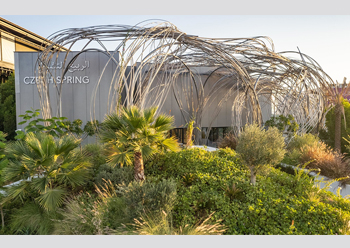Taqeef showcases power of VRF technology
VRF technology, which is claimed to help greatly reduce the carbon footprint of buildings, was installed at three pavilions at Expo 2020 Dubai. Taqeef elaborates on the highlights of the technology.
01 April 2022
Advanced green cooling solutions fitted out by the UAE-based Taqeef at three pavilions – those of Germany, Czech Republic and Pakistan – at Expo 2020 Dubai have successfully completed six months of operations during the mega event.
These solutions included the new generation of Midea variable refrigerant flow (VRF) technology which is engineered to help the projects achieve exemplary sustainable cooling, says the company.
VRF technology can help greatly reduce the carbon footprint of buildings by alternating the refrigerant volume in a system to match a building’s precise cooling requirements. This means the system utilises the minimum amount of energy required to maintain set temperatures, and it automatically adapts according to the room occupancy levels detected via a sensor.
In short, it achieves the temperature requirements by cooling only when it needs to, which saves on energy usage and costs and carbon emissions.
 |
|
Germany’s pavilion was supplied with 190 Midea VRF units to cool 37,600 sq ft of space. |
This adaptable and modular technology – which sees multiple indoor units linked to a single outdoor one – was a strategic fit for the Expo 2020’s core theme of sustainability and technology of the future, showcasing large multi-space smart HVAC solutions on a celebrated, global platform, Taqeef states.
The ‘edutainment’-focused German pavilion, located within the Sustainability District of Expo 2020, was supplied with 190 Midea VRF units to cool 37,600 sq ft of space; while in the Opportunity district, the 24,918-sq-ft Pakistan pavilion was fitted with 37 units, and a further 45 units were installed to cool the 7,777-sq-ft Czech Republic Pavilion.
Elaborating on the Czech Republic Pavilion, which showcased state-of-the-art architectural design complemented with ecotechnology innovations, Atta Alrayyes, Senior Manager-Product of Taqeef, says the brief was to ensure optimum cooling of the two-storey building with a solution devised to cater to the surge of visitors throughout the six months of the event.
“The pavilion’s trailblazing architectural design, however, presented several cooling challenges: a ground floor encased in glass windows and doors meant the pavilion is bathed in sunlight. Fluctuations in visitor occupancy and outdoor temperatures further compounded this issue. Plus, the requirement for a single thermostat for multiple indoor units and space constraints that restricted the installation of outdoor units meant design parameters were tight,” he says.
To address these issues, Taqeef provided the new generation of Midea VRF technology, which played an integral role in accommodating the cooling requirement for varying weather profiles and occupancy levels, according to Alrayyes.
“The inverter-driven compressor allowed for the adjustment of the cooling capacity of the air-conditioning system based on the load requirements, setpoint temperature, and ambient temperature. The compressor’s speed was constantly adjusted even if there was a slight variation in the load requirements within the pavilion,” Alrayyes explains. “In conjunction with this, the presence of electronic expansion valves in the indoor units ensured precise distribution of refrigerant across each of the indoor units. Furthermore, the compressor’s revolutionary design is specifically tailor-made for the Middle East and, therefore, results in passive energy savings despite the demand for high cooling. This is a testament to Taqeef’s commitment to adopting sustainable cooling solutions that are in alignment with regional efforts in curbing overall consumption.”
All the units have a DC fan motor that offers substantial improvements in operating efficiency compared to the conventional AC motors.
One of the key benefits of installing the Midea VRF systems was that it also provided the versatility of having few outdoor units connected to multiple indoor units. As a result, the overall footprint and installation costs were significantly reduced. An advanced controller was also seamlessly integrated into the design to allow multiple indoor units to be group controlled from one central point, he says.
In the end, despite the intricacy of the design, Taqeef was able to fulfil the technical challenges that were posed during the planning and design phase through smart, HVAC products and technologies.
According to Alrayyes, the project was completed before the deadline set by the client ahead of the Expo 2020 opening.
“There is a clear correlation between VRF and energy savings and it’s important that high-profile projects like Expo – which have such significant strategic importance to a global audience – showcase the most advanced and efficient HVAC systems,” remarks Diya Alami, Operations Director, Taqeef. “Midea’s VRF presents clear and auditable cost, infrastructure and energy-efficiency benefits, and long-term proficiency in terms of operating expense with reduced electrical consumption. It also delivers powerful and adaptable cooling which makes it the HVAC technology of choice for buildings large and small that want superior cooling that’s sustainable too.”
With 50 years of HVAC leadership, Taqeef is setting the agenda for more conscious cooling – with cleaner, greener systems and designs in the residential and commercial HVAC space, adds Alami.
- Taqeef showcases power of VRF technology
- Empower expands its niche portfolio, network
- AI offers smart way to cool buildings: study



